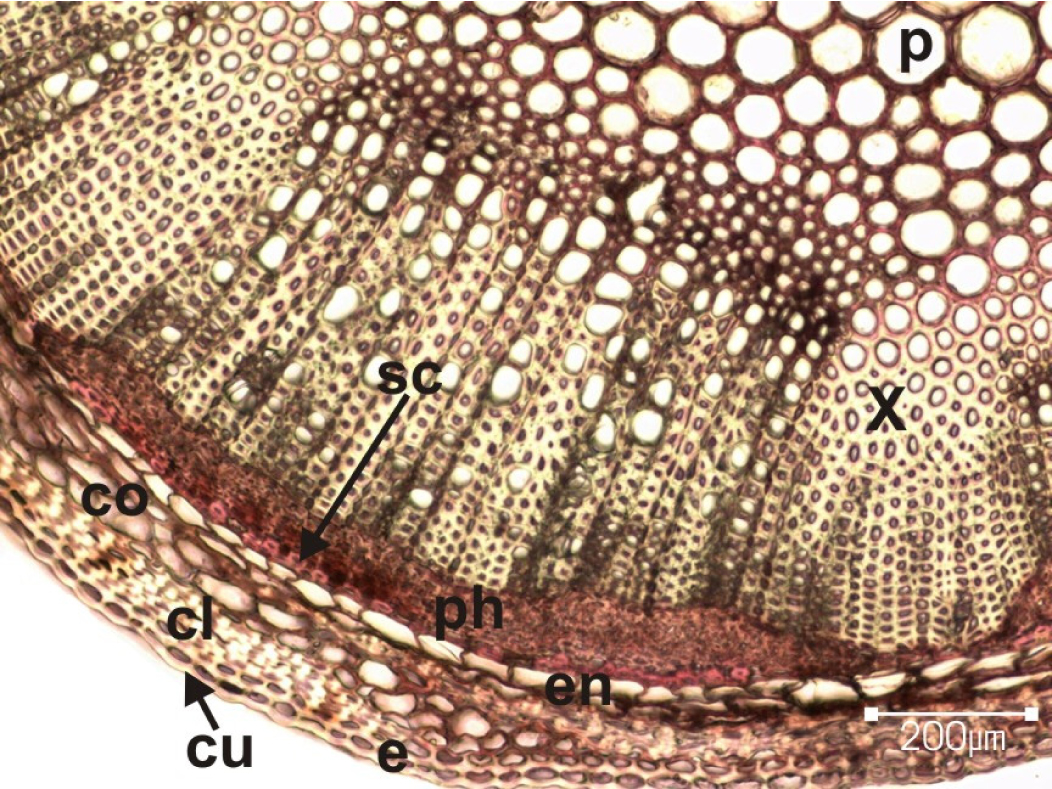Anatomical characteristics of Turkish steno-endemic Origanum leptocladum Boiss. (Lamiaceae)
Abstract
Origanum leptocladum Boiss. is an endemic East Mediterranean element, naturally growing only in Ermenek district of Karaman province in Turkey. The aim of this study is to determine anatomical features of the species. The study materials were collected from Karaman-Ermenek in 2009 and then preserved in 70 % alcohol. O. leptocladum generally exhibits the anatomical feaures of the family Lamiaceae. Hovewer, herbaceaus stem is weakly-rectangle shaped or tends to be circular, the collenchymatic tissue at the corner of the stem and scleranchymatic pericycle around the vascular tissue are weakly-developed. The most striking anatomical feature is that leaf lamina is dorsiventral in the region near to midvein, but equifacial out of the midvein. According to the results, while the stomata are of mesomorphic type on the leaf surfaces, O. leptocladum has xeromorphic characters such as palisade richness in mesophyll, the occurrence of rich scleranchymatic tissue in midvein and cuticle thickness on leaf surface.
References
Başer K.H.C. 1993. Essential oils of Anatolian Lamiaceae: A profile. Acta Hortic. 333: 217–238.
Baytop T. 1984. Türkiye’de Bitkiler ile Tedavi, İst. Üniv. Yay.
Davis P.H., Mill R.R., Tan K. (eds.). 1988. Flora of Turkey and the East Aegean Islands, Vol. 10 : 206–207. Edinburgh Univ. Pres., Edinburgh.
Doğu S., Dinç M. 2011. Endemik Origanum saccatum P.H. Davis (Lamiaceae) üzerine anatomik bir çalışma. Ot Sist. Bot. Derg. 18 (2): 45–55.
Duman H. 2000. Origanum L. In: Güner A., Özhatay N., Ekim T., Baser K.H.K. (eds.), Flora of Turkey and the East Aegean Islands. 11: 207–208. Edinburgh Univ. Pres, Edinburgh.
Duman H., Başer K.H.C., Aytaç Z. 1998. Two new species and a new hybrid from Anatolia. Turk. J. Bot. 22: 51–55.
Duman H., Aytaç Z., Ekici M., Karavelioğulları F.A., Dönmez A.A., Duran A. 1995. Three new species (Labiatae) from Turkey. Flora Mediteranea 5: 221–228.
Gönüz A., Özörgücü B. 1999. An ınvestigation on the morphology, anatomy and ecology of Origanum onites L. Turk. J. Bot. 23: 19–32.
Ietswaart J.H. 1980. A taxonomic revision of the genus Origanum (Labiatae). Leiden Botanical Series 4. Leiden University Press, The Hague, Leiden.
Ietswaart J.H. 1982. Origanum L. In: Davis P.H. (ed.), Flora of Turkey and the East Aegean Islands. Vol. 7: 297–313. Edinburgh Univ. Pres., Edinburgh.
Kaya A., Demirci B., Başer K.H.C. 2009. Compositions of essential oils and trichomes of Teucrium chamaedrys L. subsp. trapezunticum Rech. fil. and subsp. syspirense (C. Koch) Rech. fil. Chemistry & Biodiversity 6 (1): 96–104.
Meidner H., Mansfield T.A. 1968. Physiology of Stomata. McGraw-Hill, London.
Moon H.K., Hong S.P., Smets E., Huysmans S. 2009. Phylogenetic significance of leaf micromorphology and anatomy in the tribe Mentheae (Nepetoideae: Lamiaceae). Bot. J. Linn. Soc. 160: 211–231.
Navarro T., El Oualidi J. 2000. Morfología de los tricomas en Teucrium L. (Labiatae). Una revisión taxonómica. Anales Jard. Bot. Madrid 57 (2): 277–297.
Stevens P.F. 2001. Angiosperm phylogeny website. Version 6. May 2005. http://www.mobot.org/MOBOT/ research/APweb/
Vardar Y. 1987. Botanikte Preparasyon Tekniği. İzmir.


This work is licensed under a Creative Commons Attribution-NonCommercial-NoDerivatives 4.0 International License.
The journal is licensed by Creative Commons under BY-NC-ND license. You are welcome and free to share (copy and redistribute the material in any medium or format) all the published materials. You may not use the material for commercial purposes. You must give appropriate credit to all published materials.
The journal allow the author(s) to hold the copyrights and to retain publishing rights without any restrictions. This is also indicated at the bottom of each article.





